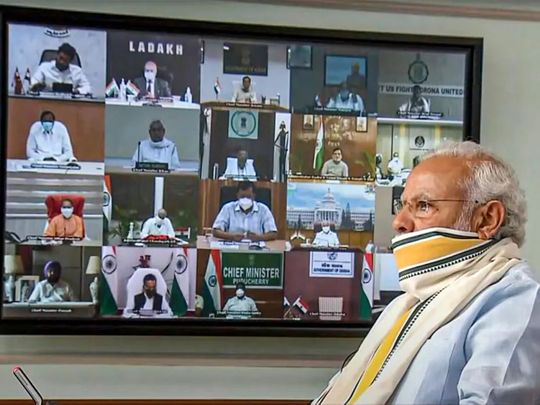
India Today magazine commissions a national survey every six months. Called the Mood of the Nation Survey, it’s the sort of thing you see in countries like the United States and UK on a weekly basis.
The latest edition of the survey, just released, finds Prime Minister Narendra Modi’s approval rating has dropped sharply from 74% in January 2021, to 54% in August 2021, just 7 months later. We know why this has happened: the government was caught by surprise by a devastating second wave of COVID-19. The consequences that people are reeling with are not just about health and loss of lives but also a deepening sense of economic crisis.
Narendra Modi’s peak is so high that even when he falls sharply, he is above 50% approval ratings. A similar sense of economic gloom had ensured the exact same popularity rating of 54% for Modi in January 2019, months before the national election. A series of economic measures, such as doles to small farmers, and a national security crisis with Pakistan, saw Modi sweep the elections and his ratings shot through the roof.
Low approval ratings
Modi has time on his side to recover. He is also blessed with a half-dead opposition. The people who should be more worried than Modi are the 30 chief ministers of India. Each one of them. The survey finds that in their own home states, no chief minister is crossing the 50% mark in approval ratings.
Take the case of Naveen Patnaik, India’s longest serving chief minister, who has genuinely turned around his state. His ratings in the survey among respondents in Odisha have failed from 75% in August 2019 to 38% in August 2021. Odisha hasn’t been especially badly affected by COVID-19. The economic recession, however, the loss of jobs, incomes, wages and hope, is what is showing in these numbers.
In the state of Jharkhand, run by the young, savvy Hemant Soren, a good 63% people approve of his handling of COVID-19. And yet his approval rating stands at a poor 19%. This is proof that the people’s economic pain points are making Indian chief ministers very unpopular — dragging them down much more than they are affecting Prime Minister Narendra Modi.
The Uttar Pradesh assembly elections are just 6 months away. The survey regularly finds Yogi Adityanath to be the most popular chief minister with voters across India. But how do respondents in his own state rate him? His ratings have gone down from 49% in August 2020 to 29% in August 2021. This does not bode well for him.
A disenchanted populace
Chief ministers who have recently won elections or re-elections in May, just as COVID-19 second wave was rising, should be expected to have good ratings. After all, voters just endorsed them and people give them time to perform before getting disenchanted.
Indeed, the most popular chief minister in his own state, according to the survey, MK Stalin in Tamil Nadu. A number of initiatives by his new government are laudable. Yet his popularity rating is only 42%.
Mamata Banerjee’s ratings have collapsed from 59% in August last year to 30% this year, soon after winning a 2/3rd majority. Rajasthan’s well-liked Ashok Gehlot has come down from a high of 73% to a low of 22% in just a year.
These are incredibly sharp falls, indicating that the Indian public is extremely unhappy, gloomy, disenchanted, upset, let down, despondent, hapless. This should worry all of India’s 30 chief ministers, since the BJP smartly passes on all responsibility to state governments in their door-to-door campaign.
It is the chief ministers who will suffer in elections, since they don’t have money to throw around to help the people’s pockets. The CMs will face backlash. The media may not show it now, because the media talks to voters only during elections.
Absolutely no one is spared from this backlash, regardless of party, ideology, personal likeability, governance style, or however you like to judge a leader. In the space of a year, Arvind Kejriwal is down from 63% to 22% approval ratings. Bhupesh Baghel in Chhattisgarh is at 19%, Himanta Biswa Sarma of Assam at 29%, and the uber popular Pinarayi Vijayan at a mere 35%.
State chief ministers will now need to think out of the box, come up with new policies and programmes despite not having much fiscal room to do so. We cannot live in denial for far too long about the fact that we are already going through stagflation — a deadly mix of inflation and unemployment.
The people could be fooled with identity politics or clever PR when they didn’t have jobs. But for prices to go up when incomes are going down, we can’t expect people to remain silent spectators. Speak they will, if only through the right to vote.








